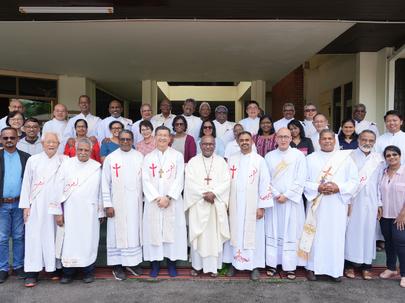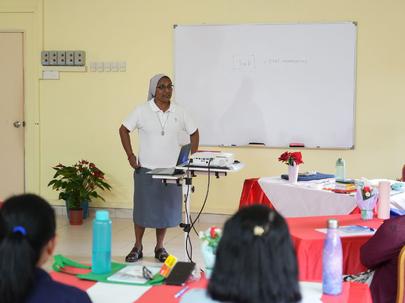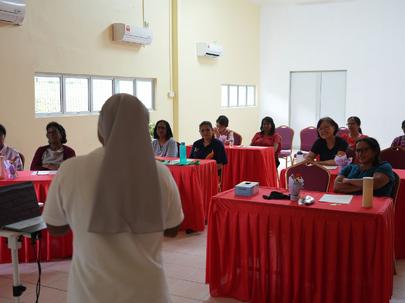Annual gathering of Permanent Deacons in Malaysia
The annual gathering of Permanent Deacons, diaconate candidates, and their spouses took place at Majodi Centre from 30 April to 2 May 2025. The main theme was: Deacons as Image of Mercy
By: Isaac Alfred Simbun
The annual gathering of Permanent Deacons, diaconate candidates, and their spouses took place at Majodi Centre From 30 April to 2 May 2025. The event welcomed 17 deacons and their wives from the Penang and Malacca-Johore Dioceses, along with six candidates in formation. This year’s gathering was honoured by the presence of Bishop Bernard Paul, Rev. Rev. Fr. Adrian Francis and Sr. Shanti M. FdCC from the Malacca Johore Diocese and Archbishop Julian Leow together with Rev. Fr. Edwin Peter from Kuala Lumpur Archdiocese. Cardinal Sebastian Francis, originally scheduled to speak, was called to the Vatican for the conclave. Unlike last year’s assembly in Bukit Mertajam which focused on synodality, this year’s Deacons/wives gathering’s focus aligned with Pope Francis’s message for the Jubilee of Deacons, emphasizing the call for deacons to embody the Image of Mercy. Two concurrent sessions were held—one for the deacons and candidates, and another for their wives. The sessions for the wives were led by Sr. Shanti M., FdCC, and continued until the final day. The event also served as the annual joint formation session for deacons, their spouses, and candidates from across Peninsular Malaysia.
The first session was led by Bishop Bernard Paul and centred on the theme of the Image of Mercy. In his talk, Bishop Bernard emphasized that the diaconate is deeply rooted in a threefold ministry: the Word, the Altar, and Charity—each reflecting a distinct dimension of Christ’s own mission of mercy and service. Deacons are ordained servants of the Word, entrusted with proclaiming the Gospel amid a world plagued by uncertainty, anxiety, and moral confusion. They are also ministers of the Altar, assisting in the sacred liturgy and reflecting the humility of Christ through their liturgical presence and gestures of service. Furthermore, they are ministers of Charity, called to enact mercy in tangible ways—especially toward the poor, the forgotten, and the vulnerable—echoing the role of the first deacons who were appointed to serve at table and care for widows.
The identity of the deacon is inseparably linked to the identity of a servant. The act of foot-washing remains the Church’s enduring symbol of the diaconal vocation. Deacons are not assistant priests or ceremonial functionaries; their role is unique, indispensable, and rooted in the early Church’s response to injustice and inequality. In a world undergoing rapid cultural shifts, demographic changes, and existential crises of truth and meaning, deacons are called to be visible signs of mercy and stable anchors of hope. They must be conscious of how they are perceived—often misunderstood—and continually return to the heart of their vocation: not to be honoured, but to serve.
Given that most Permanent Deacons are married, the challenges of family life are real and cannot be ignored. In the second session, Archbishop Julian Leow spoke on the Image of Mercy in the context of the family and the New Evangelization. Deacons, especially those who are married, live a distinctive vocation that integrates family, ministry, and work. Their first responsibility is to the family. As husbands and fathers, they must balance diaconal service with their essential role within the domestic Church. Deacons are called to be bridges between the Church and the world, beginning at home. Their families are not an add-on to their ministry—they are a core part of their witness. In a world of shifting values and family dynamics, deacons must model Gospel fidelity through prayer, presence, and example. The credibility of a deacon’s public ministry is closely tied to how he lives the Gospel privately.
Archbishop Julian reminded the gathering of Pope Francis’ teaching on the reciprocity between marriage and ordination, where the married deacon embodies both sacraments and can speak authentically to the realities of family life. Because of their lived experience, deacons are especially suited to support other families, serve as peacemakers in the parish, and bridge gaps between clergy and laity. But the vocation is not without tension. Many deacons juggle competing priorities—parish duties, professional commitments, and family needs—often leading to emotional strain or marital stress. Open communication with their spouses is vital. Sessions like this offer a space not only to name the struggles, but to explore shared solutions: how to manage time, expectations, and emotional well-being. Ultimately, the deacon’s first mission field is his home. It is there that his witness to mercy, humility, and love is most needed—and most tested.
Archbishop Julian also spoke on the reality of Permanent Deacons in the marketplace—a vital, yet often overlooked, mission field. Since deacons financially support themselves through secular employment, their commitment to their work is as important as their responsibilities to the Church and their families. Deacons are uniquely positioned as bridges between the Church and the world, called to be faithful witnesses of Christ not only in parishes and homes, but especially in their places of work. As clerics in secular professions, they live a dual identity: both men of the cloth and men of the marketplace. his dual role presents a strategic opportunity for evangelisation—not through preaching alone, but through personal integrity, compassion, and moral clarity in environments where Gospel values are often absent. Whether in offices, schools, factories, or boardrooms, deacons are called to make Christ present through their daily conduct.
The New Evangelisation goes beyond reaching non-believers; it includes reawakening the faith of lapsed Catholics and engaging secularised cultures. Deacons, by virtue of their position, can accompany people where clergy often cannot—at the heart of everyday life. But effective witness begins with the deacon himself. As Archbishop Julian noted, “You cannot give what you do not have.” Without a personal relationship with Christ, a deacon’s ministry risks becoming hollow. Ongoing prayer, formation, and sacramental life are essential foundations.
In today’s noisy, distracted world, deacons must be anchored in truth and silence, drawing strength from the Eucharist and daily discernment. Their moral credibility at work matters: do their actions reflect the Gospel? Are they known not just by title, but by character? Sometimes, it is the quiet witness that speaks loudest—a sign of the cross, a moment of prayer, or the courage to address injustice or unethical practices. As leaders or employees, deacons must model just and compassionate leadership. Their lives should spark curiosity: “What’s different about you?” This opens the door to evangelisation—not by argument, but by authentic example. The conversion is God’s work, but the deacon’s role is to faithfully sow the seeds. In short, the workplace is not separate from the deacon’s ministry. It is a true mission field, where credibility, consistency, and quiet courage can become a living homily.
The fourth session was delivered by Rev. Fr. Edwin Peter, who raised a vital and often overlooked question: What is the true identity of a deacon? His lecture invited participants to reflect not only on their function, but on how they live, serve, and will ultimately be remembered. Deacons are called not merely to serve, but to examine their identity, witness, and legacy—how they will be remembered by the Church, their families, and society. The question “How would you like to be remembered?” is not sentimental—it is vocational. It urges deacons to consider the authenticity of their lives, the integrity of their service, and the mercy they embody daily.
A deacon’s ministry is not defined by title or visibility, but by becoming a living expression of mercy—especially in homes, workplaces, and among the forgotten. The aim is not simply to do acts of charity but to become merciful persons, following the example of Pope Francis in humility, tenderness, and simplicity. Each deacon brings a unique personality—organiser, catalyst, thinker, helper—which shapes how he lives his vocation. There is no one “ideal” deacon, but all are called to self-awareness, growth, and intentional service. For married deacons, this includes navigating the complex demands of family life with emotional maturity and pastoral wisdom.
Drawing from movements like Marriage Encounter and Retrouvaille, Fr. Edwin underscored how character and disposition influence ministry. Emotional intelligence, timing, and empathy are not optional—they are essential tools of service. From the early Church to today, deacons have been chosen for servanthood, not status. Their ministry must go beyond function to become a ministry of mercy, grounded in personal transformation.
Fr. Edwin also referenced Pope Francis’s vision of a synodal Church—inclusive, humble, and always on the move. Notably, the Pope’s imagery often leaves out clerical symbols, including priests and deacons. This, he argued, is not an oversight but a prophetic call: deacons are not to dominate the journey, but to walk humbly with others, enabling and empowering them. The deacon is thus called to move from being an image of mercy to an icon of mercy—not just representing mercy but embodying it sacramentally. In a world saturated with noise and superficiality, the deacon as icon is quiet, radiant, and Christlike—not remembered for grandeur, but for mercy made visible in daily life.
After the four preceding sessions, Bishop Bernard Paul delivered the final lecture, offering a mission-oriented reflection that grounded the gathering in clarity and purpose. He emphasized that the direction ahead is unmistakable: deacons are called to become servants of God’s mercy—a mission that includes both the ordained and those mandated for special ministries. At the heart of this mission is a return to the original diaconal identity, especially the threefold ministry entrusted to deacons: The ministry of the Word, the Altar and the Charity.
Bishop Bernard reminded the assembly that the Church does not exist only for those who attend—it exists especially for those at the peripheries, echoing Pope Francis’ call to go to the margins. Deacons must be present where people are hurting—not as distant functionaries, but as companions who identify with their struggles. Deacons are to follow the kenosis of Christ—emptying themselves to enter sinful and broken situations with humility. Their role is not to draw attention to themselves, but to be signposts pointing to Christ, much like Andrew and John the Baptist. The scriptural roots of the diaconate, found in Acts, reveal that the first deacons were entrusted with the care of widows and the poor. Today, that mission continues where charity is not a ministry to outsource, but a way of life to embody.
Bishop Bernard urged deacons to be not just individuals of service, but also mobilizers and organizers—able to lead parish and diocesan efforts in responding to natural disasters, social crises, and long-term needs. One local example was highlighted: a deacon who coordinated disaster relief efforts with NGOs and volunteers, modelling the organized mercy of the Church. Ultimately, every baptized person is called to live charity. But the deacon is tasked with making that call visible, real, and enduring—not seasonal, but sustained and systemic. In this, the deacon becomes not only a servant, but a leader of mercy in action.
Reflecting on the role of deacons’ wives, Bishop Bernard emphasized that they are not simply companions by association, but essential partners in the diaconal vocation. Their participation is rooted not only in support but in a distinct and active witness to the Church’s mission. Through their prayer, presence, and works of mercy—often carried out quietly and sacrificially—they become living signs of Christ’s compassion, especially at the margins where the Church is most needed. One of the sessions, led by Sr. Shanti M., FdCC, beautifully complemented this reflection. She invited the wives to embrace mercy by accepting the brokenness within themselves and others, using the image of Kintsugi—the Japanese art of mending broken pottery with gold. Just as the cracks are not hidden but made radiant, so too our imperfections, when healed by grace, can become a source of beauty, strength, and deeper communion with those we serve.
In today’s complex society—marked by secularism, misinformation, migration, and mental health challenges—deacons must be self-aware, spiritually grounded, and pastorally responsive. As servants of the Church, they are called to model humility over entitlement, inclusion over exclusion, and mercy over fear. The deacon, ultimately, is a living reflection of Christ the Servant—not acting in isolation, but as one who participates in the mission of Christ and His Church. At the heart of this calling lies a profound truth: the image of God we hold will shape the kind of deacon we become.


